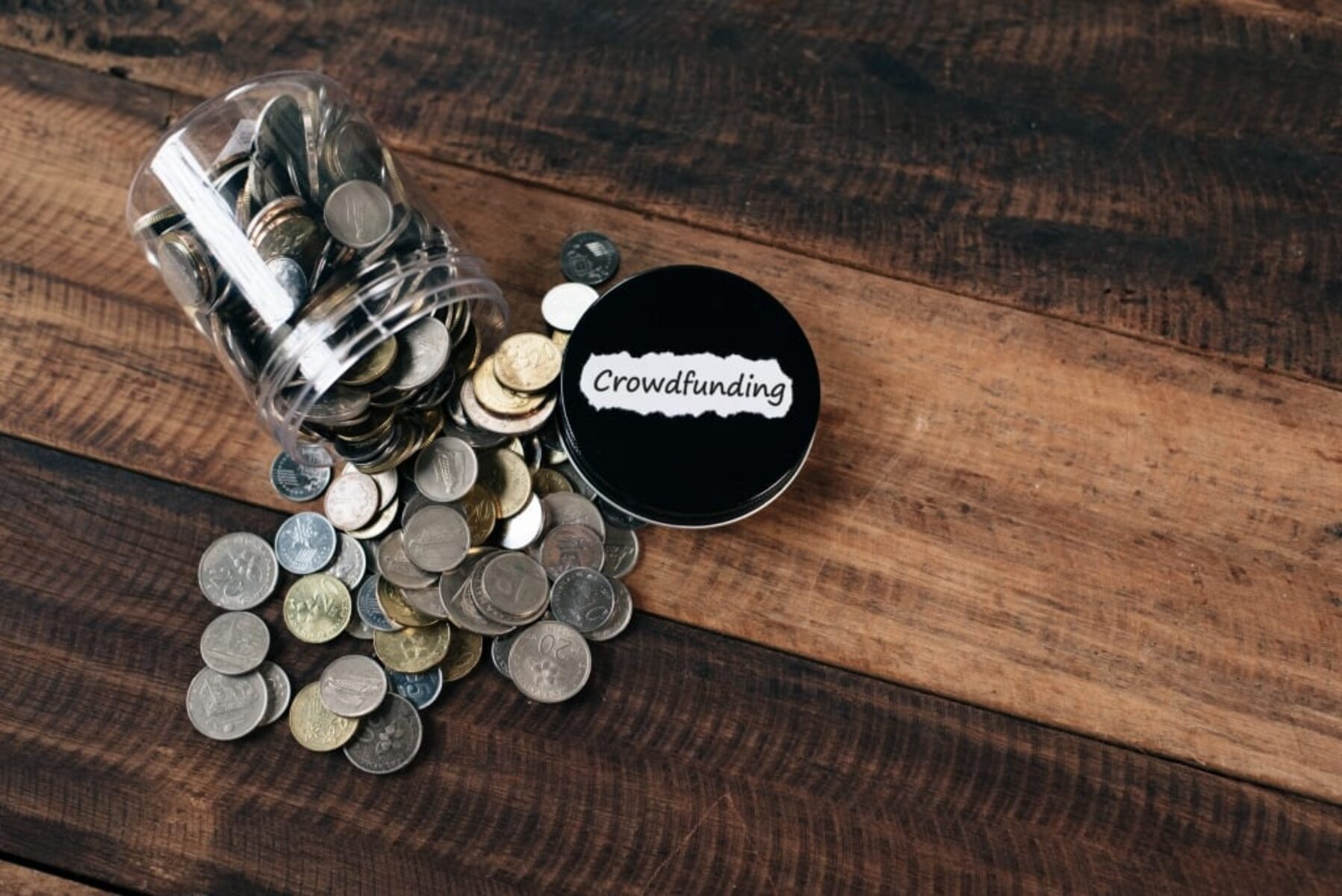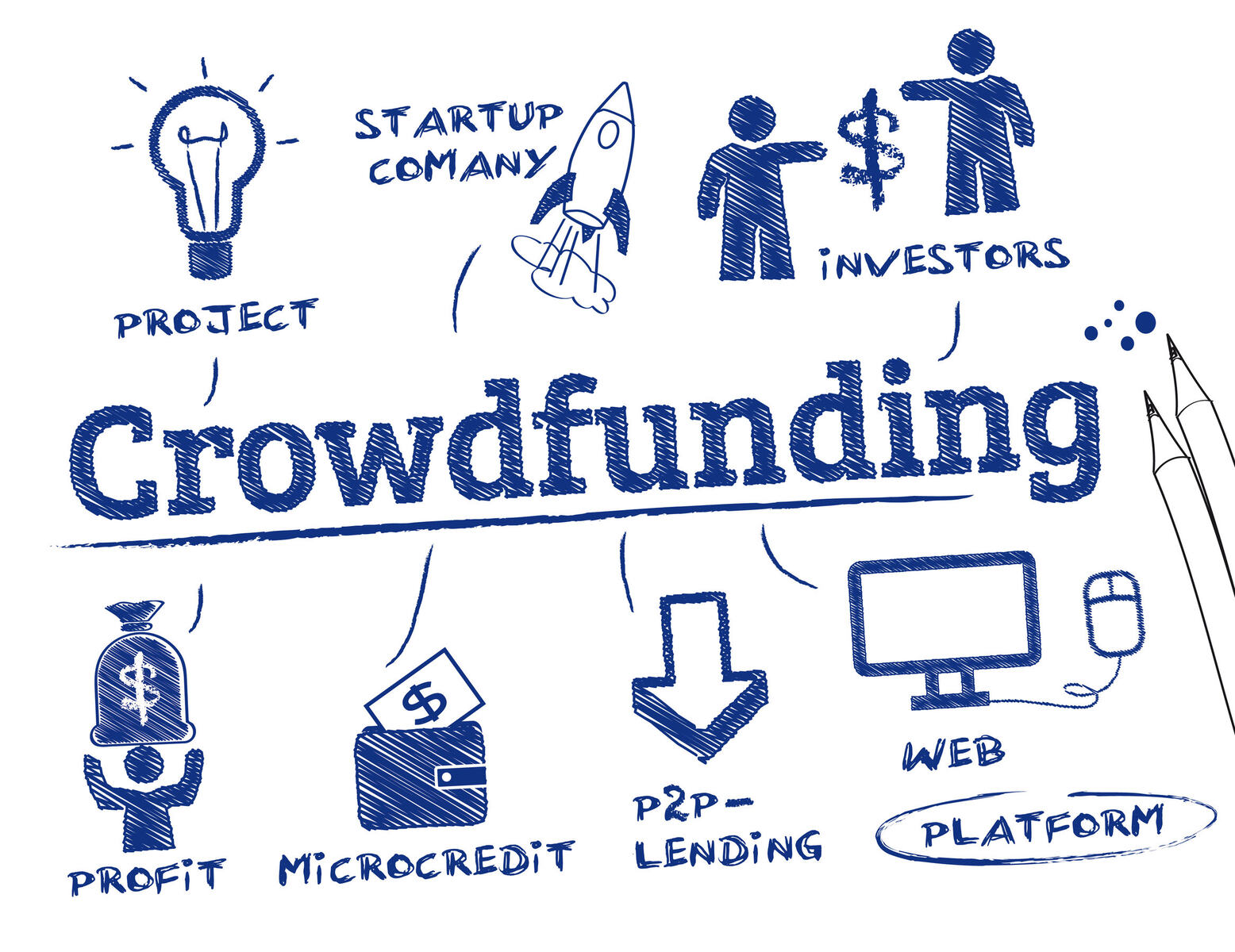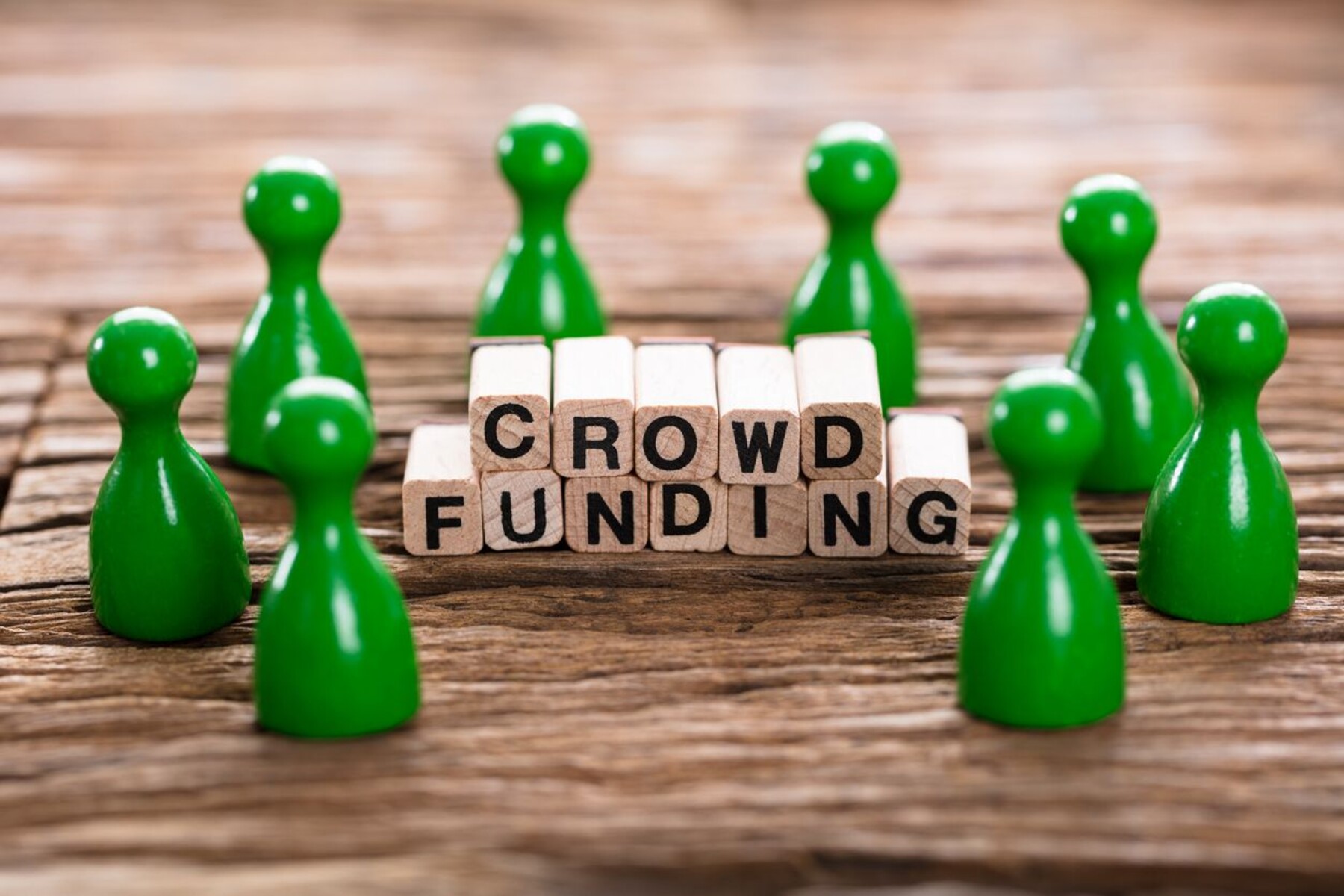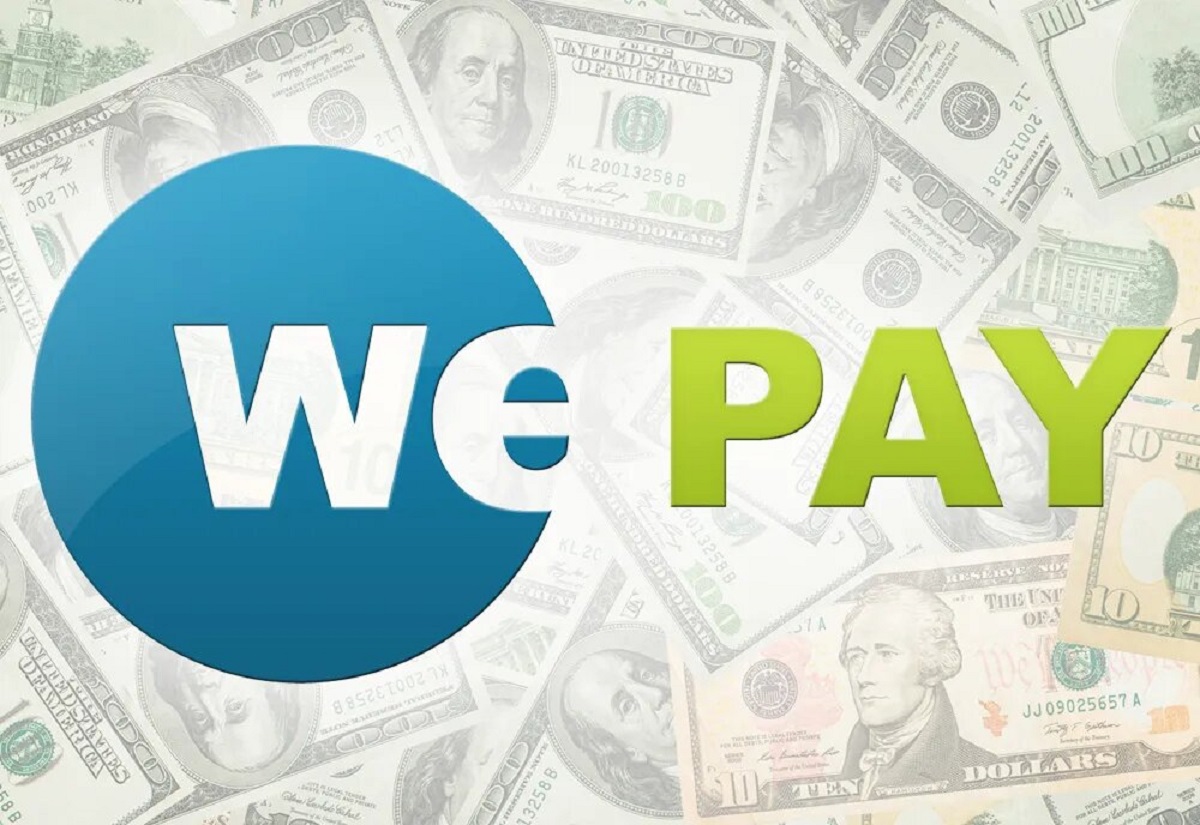Introduction
Welcome to the world of crowdfunding! In recent years, crowdfunding has emerged as a popular and effective way for individuals and businesses to raise funds for their projects and ventures. Whether you’re an entrepreneur with an innovative startup idea, an artist looking to produce your next masterpiece, or a non-profit organization in need of financial support, crowdfunding platforms provide a unique opportunity to connect with a global community of potential backers.
Crowdfunding, as the name suggests, involves raising funds from a crowd of people who believe in your idea and are willing to contribute. Unlike traditional methods of financing, crowdfunding allows you to tap into a vast network of individuals who are passionate about various causes and eager to support projects they resonate with.
One of the key advantages of crowdfunding is its ability to democratize financing. It eliminates the need to rely solely on banks, investors, or grants, which can be difficult to access, especially for those who are new to the entrepreneurial or creative scene. With crowdfunding, anyone can pitch their idea and invite the public to back them financially, essentially turning small contributions into a substantial sum.
Moreover, crowdfunding platforms offer more than just financial support. They provide a platform for creators and entrepreneurs to showcase their ideas, build a community around their project, and receive valuable feedback and support from their backers. By engaging directly with their audience, creators can establish a loyal following and gain exposure for their work.
In this article, we will explore the world of crowdfunding platforms. We will discuss the different types of crowdfunding models, the advantages and disadvantages of utilizing crowdfunding, the necessary planning and considerations when creating your own crowdfunding platform, and the crucial steps to building and promoting a successful platform.
So, whether you’re considering launching your own crowdfunding platform or simply interested in learning more about the booming industry, let’s dive in and explore the exciting world of crowdfunding and all it has to offer!
Understanding Crowdfunding
Crowdfunding is a modern method of raising funds where individuals or businesses seek financial support from a large number of people, typically through an online platform. This method has gained significant popularity in recent years, revolutionizing the way projects are funded. But what exactly is crowdfunding and how does it work?
At its core, crowdfunding is based on the principle of collective support. It allows project creators to reach out to a broad audience, often referred to as the “crowd,” to gather small contributions that collectively add up to the desired funding goal. These contributions can come in various forms, including donations, pre-orders, investments, or rewards.
There are different types of crowdfunding models that cater to specific needs and objectives. The most common types include donation-based crowdfunding, reward-based crowdfunding, equity crowdfunding, and debt-based crowdfunding.
In donation-based crowdfunding, supporters contribute money without expecting anything in return. This model is commonly used for charitable, humanitarian, or social causes. Supporters are driven by the desire to make a positive impact and help those in need.
Reward-based crowdfunding appeals to backers by offering them certain rewards or incentives in exchange for their monetary support. These rewards can range from exclusive access to the project, limited edition merchandise, or personalized experiences. This model is often used for creative projects, such as art, music, film, or technology.
Equity crowdfunding allows investors to purchase shares or stakes in the project or company they are backing. In return, they become partial owners and have the potential to earn dividends and benefit from the project’s success. This model is commonly used by startups and entrepreneurs looking for investment to grow their businesses.
Debt-based crowdfunding, also known as peer-to-peer lending, involves individuals lending money to others with the expectation of receiving the principal amount plus interest over a designated period. This model is often used for personal loans, business financing, or real estate investments.
Crowdfunding brings several benefits for both project creators and backers. For creators, crowdfunding provides access to funding without the need for traditional financial intermediaries. It allows them to showcase their projects, build an audience, and receive validation and feedback from potential customers or investors.
On the other hand, backers get the opportunity to support projects they believe in and have a personal connection with. They can be part of the journey, witness the project’s progress, and feel a sense of satisfaction for contributing to its success.
Now that we have a basic understanding of crowdfunding and its different models, let’s explore the advantages and disadvantages of utilizing this funding method in the next section.
Types of Crowdfunding Platforms
Crowdfunding platforms play a crucial role in connecting project creators with potential backers. These platforms provide the infrastructure and tools necessary to facilitate the crowdfunding process. However, not all crowdfunding platforms are the same. There are various types of platforms, each catering to different funding models and industries. Let’s explore some of the most common types:
1. All-or-Nothing Platforms: These platforms operate based on an all-or-nothing funding model. Project creators set a funding goal, and if the goal is not met within a specified timeframe, all contributions are returned to the backers. This model provides a sense of security for backers, as they are assured that their funds will only be used if the project receives enough support to be successful. Kickstarter is a well-known example of an all-or-nothing platform.
2. Keep-It-All Platforms: Unlike all-or-nothing platforms, keep-it-all platforms allow project creators to keep the funds raised regardless of whether the funding goal is met or not. This model gives creators more flexibility but also puts the risk on the backers, as they may be supporting projects that do not reach their full potential. Indiegogo is a popular example of a keep-it-all platform.
3. Donation-Based Platforms: These platforms focus on supporting charitable or social causes, where backers contribute money without expecting any personal benefit or financial return. They are driven purely by the desire to make a positive impact. GoFundMe is a well-known donation-based platform.
4. Reward-Based Platforms: Reward-based platforms are geared towards creative projects, such as art, music, film, or technology. Backers support projects by making a monetary contribution in exchange for rewards or incentives offered by the project creator. These rewards can range from exclusive access to the project, limited edition merchandise, or personalized experiences. Kickstarter and Indiegogo offer reward-based crowdfunding options.
5. Equity Crowdfunding Platforms: Equity crowdfunding platforms allow backers to invest in startups or businesses in exchange for shares or a stake in the company. This model gives backers the potential to earn dividends and benefit from the project’s success. Equity crowdfunding platforms are often regulated by financial authorities to ensure investor protection. SeedInvest and Fundable are examples of equity crowdfunding platforms.
6. Real Estate Crowdfunding Platforms: Real estate crowdfunding platforms focus on connecting investors with real estate development projects. These platforms give investors the opportunity to become partial owners or lenders in real estate ventures. RealtyShares and PeerStreet are popular real estate crowdfunding platforms.
It’s important to choose the right crowdfunding platform that aligns with your project’s goals, funding model, and target audience. Conduct thorough research, read reviews, and consider the platform’s fees, features, and track record before making a decision.
Now that we have explored the different types of crowdfunding platforms, let’s delve into the advantages and disadvantages of utilizing crowdfunding in the next section.
Advantages and Disadvantages of Crowdfunding
Crowdfunding offers a unique approach to financing projects, enabling individuals and businesses to raise funds from a diverse group of backers. However, like any funding method, crowdfunding has its advantages and disadvantages that project creators should consider. Let’s explore some of these pros and cons:
Advantages of Crowdfunding:
- Access to Funding: Crowdfunding provides access to funding without the need for traditional financial intermediaries. This is particularly beneficial for individuals or businesses that may not have access to traditional financing options or have difficulty securing loans or investments.
- Validation and Feedback: Crowdfunding allows creators to validate their ideas and receive real-time feedback from potential customers or investors. Backers can provide valuable insights that can help improve the project or service before it is fully launched.
- Market Exposure: Crowdfunding platforms often have a built-in community of supporters and backers, providing exposure and visibility for projects. This can help creators gain traction, attract a wider audience, and create buzz around their project.
- No Repayment Obligations: In reward-based crowdfunding, project creators do not have to repay the funds received, as backers are motivated by the rewards or incentives offered. This eliminates the burden of debt for creators.
- Potential for Pre-sales: For product-based projects, crowdfunding offers the opportunity to generate pre-sales before the product is officially launched. This helps creators gauge demand and manage production and inventory accordingly.
Disadvantages of Crowdfunding:
- Time and Effort: Running a crowdfunding campaign requires a significant amount of time and effort. From creating a compelling project page to marketing and engaging with backers, managing a campaign can be demanding, particularly for solo entrepreneurs or small teams.
- High Competition: Crowdfunding platforms are flooded with projects competing for attention and funding. Standing out from the crowd and capturing the interest of potential backers can be challenging, especially in popular categories.
- Risk of Failure: Crowdfunding success is not guaranteed. There is always a risk that projects may not meet their funding goals, resulting in the campaign being unsuccessful. This can lead to wasted time and effort for project creators.
- Loss of Control: When crowdfunding, project creators may face challenges in maintaining complete control over their projects. They may have to compromise on certain aspects to meet the expectations and demands of backers.
- Legal and Regulatory Compliance: Depending on the country and type of crowdfunding, there may be legal and regulatory requirements that project creators must comply with. These can include financial regulations, consumer protection laws, and tax obligations.
It’s essential for project creators to carefully consider these advantages and disadvantages before opting for crowdfunding as a method of financing. With proper planning and understanding of the crowdfunding landscape, creators can maximize the benefits and navigate the potential challenges.
Planning Your Crowdfunding Platform
Creating a successful crowdfunding platform requires careful planning and considerations. Before diving into the development process, it’s crucial to define your goals, target audience, and overall vision for the platform. Let’s explore the key aspects to consider when planning your crowdfunding platform:
1. Define Your Niche:
Identify the specific niche or industry that your crowdfunding platform will cater to. By focusing on a particular niche, you can differentiate yourself from existing platforms and provide a specialized experience for both project creators and backers. Consider industries such as technology, arts, education, social causes, or entrepreneurship.
2. Understand Your Target Audience:
Research and analyze your target audience to gain a deep understanding of their needs, preferences, and behaviors. This will help you design a platform that resonates with your audience and provides solutions to their pain points. Conduct surveys, interviews, or market research to gather valuable insights.
3. Create a User-Centric Experience:
Design your platform with a user-centric approach, focusing on ease of use, intuitive navigation, and seamless interactions. The platform should be visually appealing, responsive across different devices, and accessible to a wide range of users. Consider implementing features such as search functionality, project filtering, user profiles, and social sharing.
4. Implement a Strong Project Approval Process:
Establish a robust project approval process to ensure the quality and credibility of projects on your platform. This may involve verifying project creators’ identities, reviewing project proposals, and conducting due diligence to minimize the risk of fraudulent or misleading campaigns. Clear guidelines and criteria should be communicated to project creators.
5. Set Clear Fees and Policies:
Define transparent fee structures and policies for both project creators and backers. Determine the percentage of funds that will be retained by the platform as a service fee, and clearly communicate this to all parties involved. Ensure that your policies cover important aspects such as refunds, project updates, and intellectual property rights.
6. Build Trusted Payment Gateways:
Collaborate with reputable payment processors to ensure secure and reliable payment transactions on your platform. Implement multiple payment options to cater to different preferences and provide a seamless checkout process for backers. Security measures such as SSL encryption and fraud detection should be in place to protect sensitive financial information.
7. Develop a Comprehensive Marketing Strategy:
Plan a comprehensive marketing strategy to attract project creators and backers to your platform. Utilize various channels such as social media, content marketing, influencer partnerships, and targeted advertising to create buzz and drive traffic to your platform. Collaborate with creators, industry influencers, and media outlets to promote compelling campaigns and success stories.
8. Foster Community Engagement:
Encourage community engagement and interaction among project creators and backers. Implement features such as comment sections, forums, and project updates to facilitate communication and collaboration. Providing a platform for backers to connect with each other and share their experiences can contribute to a sense of community and loyalty.
9. Monitor and Iterate:
Continuously monitor and analyze the performance and feedback of your platform. Gather data on user behavior, conversion rates, campaign success rates, and user satisfaction to identify areas for improvement. Regularly iterate and optimize your platform based on these insights to enhance the user experience and maximize success rates.
By carefully planning and considering these factors, you can lay a solid foundation for your crowdfunding platform and increase its chances of success. Remember to stay updated with industry trends, be adaptable to changing needs, and prioritize the satisfaction of both project creators and backers.
Choosing the Right Platform Model
When creating a crowdfunding platform, one of the critical decisions you need to make is choosing the right platform model. The platform model determines the type of crowdfunding you will facilitate and the specific features and functionalities you will offer to project creators and backers. Let’s explore some popular platform models and factors to consider when making your choice:
1. All-or-Nothing:
In an all-or-nothing model, project creators set a funding goal, and if they do not reach the target within a specified timeframe, all contributions are returned to the backers. This model provides a sense of security for backers, as they can trust that their funds will be used only if the project reaches its full funding goal. All-or-nothing models can create a sense of urgency and motivation for backers to rally behind projects.
2. Keep-It-All:
Unlike all-or-nothing platforms, keep-it-all platforms allow project creators to keep the funds raised, regardless of whether the funding goal is met. This model gives creators greater flexibility, but it also puts the responsibility on backers to assess the project’s potential for success. Keep-it-all models may attract projects with less-defined outcomes or projects that would benefit from any amount of funding.
3. Donation-Based:
In donation-based crowdfunding, backers contribute money without expecting any financial return. This model is commonly used for charitable or social causes. It appeals to individuals driven by the desire to make a positive impact and support projects that align with their values. Donation-based platforms may require transparency and accountability from project creators in showcasing how the funds will be utilized for the intended cause.
4. Reward-Based:
Reward-based crowdfunding is based on offering rewards or incentives to backers in exchange for their financial support. These rewards can range from exclusive access to the project or limited edition merchandise to personalized experiences. Reward-based platforms are commonly used for creative projects, such as art, music, film, or technology. It’s important to define clear guidelines and ensure that rewards offered are feasible and attractive to potential backers.
5. Equity:
Equity crowdfunding allows backers to invest in startups or businesses in exchange for shares or a stake in the company. This model gives backers the potential to earn dividends and benefit from the project’s success. Equity crowdfunding platforms often have specific financial regulations and requirements to ensure investor protection. It’s essential to comply with relevant legal and regulatory frameworks when operating an equity crowdfunding platform.
6. Debt-Based:
Debt-based crowdfunding, also known as peer-to-peer lending, involves individuals lending money to others with the expectation of receiving the principal amount plus interest over time. This model is commonly used for personal loans, business financing, or real estate investments. Debt-based platforms require robust risk assessment and credit evaluation processes to protect both borrowers and lenders.
When choosing the right platform model, consider factors such as the target audience, the nature of projects you want to attract, legal compliance requirements, and your overall vision for the platform. Additionally, research and analyze the success rates and market demand for different models in your chosen industry.
Remember that selecting the right platform model is just the first step towards creating a successful crowdfunding platform. The execution, user experience, and marketing efforts will go hand in hand with the chosen model to ensure the platform’s growth and sustainability.
Building a User-friendly Interface
When it comes to building a crowdfunding platform, a user-friendly interface is paramount to ensure a seamless and satisfying experience for both project creators and backers. A well-designed interface can enhance usability, engagement, and overall platform success. Here are some essential considerations when building a user-friendly interface:
1. Intuitive Navigation:
Ensure that your platform has a clear and intuitive navigation system that allows users to easily find the information they need. Use familiar design patterns and organizing principles to create a logical flow of information. Include navigation menus, search functionalities, and breadcrumb trails to help users navigate through different sections of the platform effortlessly.
2. Responsive Design:
With the increasing use of mobile devices, it’s crucial to design your platform with responsiveness in mind. Make sure that your platform’s layout and content adapt to different screen sizes and resolutions. This will ensure an optimal viewing experience for users accessing your platform from various devices, including smartphones, tablets, and desktop computers.
3. Clear Call-to-Action (CTA) Buttons:
Use prominent and visually appealing call-to-action buttons throughout your platform. These buttons should clearly communicate the desired actions you want users to take, such as “Back this Project,” “Create a Project,” or “Explore Campaigns.” Ensure that these buttons stand out from the rest of the content and are easily accessible, prompting users to engage and interact with the platform.
4. Streamlined Registration Process:
Make the registration process as smooth and straightforward as possible. Minimize the number of steps required and only ask for essential information upfront. Consider allowing users to sign up using existing accounts from popular platforms like Google or Facebook to streamline the process even further. Provide clear instructions and tooltips to guide users throughout the registration and account creation process.
5. Engaging Project Pages:
Design visually appealing and engaging project pages that captivate the attention of potential backers. Allow project creators to showcase their projects through compelling images, videos, and descriptive text. Make it easy for backers to view project details, updates, and rewards. Incorporate social sharing buttons to encourage users to spread the word about the projects they support.
6. Transparent Project Progress:
Display project progress and funding status prominently on project pages. Use progress bars or visual indicators to show how much funding has been raised and how close the project is to reaching its goal. This transparency helps build trust and motivates potential backers to contribute to projects that are close to their funding targets.
7. Efficient Project Filtering and Sorting:
Implement filtering and sorting options that allow users to narrow down their search for projects based on criteria such as category, funding goal, popularity, or campaign end date. Provide a robust search functionality with advanced filters to help users find projects that align with their interests and preferences quickly.
8. Seamless Checkout and Payment Integration:
Design a smooth and secure checkout process for backers. Integrate trusted payment gateways that provide a variety of payment options, ensuring a seamless transaction experience. Clearly communicate the accepted payment methods, security measures, and any related transaction fees to instill confidence and trust in your platform.
9. User Feedback and Ratings:
Incorporate user feedback and rating systems to allow backers to share their experiences and opinions on projects they have supported. This feedback can help build credibility and provide valuable insights for both project creators and future backers. Consider implementing a review system, ratings for project creators, or a comment section for backers to engage with each other and project creators.
By prioritizing a user-friendly interface, you can create a positive user experience, encourage engagement, and increase the likelihood of users returning to your platform in the future.
Designing the Platform’s Homepage
The homepage of your crowdfunding platform is the virtual front door that sets the first impression for visitors. It plays a crucial role in capturing their attention, communicating your platform’s value proposition, and encouraging them to explore further. Here are some key considerations when designing the homepage of your crowdfunding platform:
1. Clear and Compelling Value Proposition:
Communicate the unique value proposition of your platform clearly and concisely. Use a compelling headline or tagline that highlights the benefits of using your platform for both project creators and backers. Make sure the value proposition is prominent and immediately visible to capture visitors’ attention and entice them to stay on your platform.
2. Visual Appeal:
Create a visually appealing homepage that reflects the spirit and essence of your platform. Use captivating and high-quality images or videos that showcase successful projects or evoke emotions related to creativity, innovation, or social impact. Opt for a clean and professional design that aligns with the overall branding of your platform.
3. Simple and Intuitive Navigation:
Design a navigation menu that is easy to understand and navigate. Keep it simple and concise, allowing visitors to access different sections of your platform with minimal effort. Consider using familiar navigation icons or labels to guide users and improve the overall user experience.
4. Highlight Featured or Trending Projects:
Showcase a selection of featured or trending projects on the homepage to create interest and intrigue. These projects can serve as examples of the diverse range of campaigns hosted on your platform. Include compelling visuals, brief descriptions, and indicators of their progress or funding status to entice visitors to explore further.
5. Prominent Call-to-Action (CTA) Buttons:
Place clear and visually appealing call-to-action buttons on the homepage to guide visitors towards taking action. These buttons can be strategically positioned to encourage project creators to start their campaigns or prompt backers to explore projects. Use action-oriented and compelling texts on the CTA buttons to create a sense of urgency or curiosity.
6. Testimonials and Success Stories:
Include testimonials or success stories from project creators or previous successful campaigns on your homepage. These can be in the form of quotes, brief anecdotes, or videos that highlight the positive experiences and results achieved on your platform. Testimonials provide social proof and build trust, encouraging potential project creators and backers to take part in your crowdfunding community.
7. Social Proof and Media Coverage:
Showcase any positive media coverage, awards, or recognition that your platform has received. Include logos or links to reputable media outlets or organizations that have featured or endorsed your platform. This helps build credibility and trust in your platform, assuring visitors that it is a reputable and trustworthy place for crowdfunding.
8. Clear Information and FAQs:
Provide concise and easily accessible information about how your platform works, its benefits, and the steps involved in creating and supporting projects. Consider including a FAQ section or a dedicated page to address common questions or concerns. This information helps visitors understand the crowdfunding process and builds confidence in your platform.
9. Engaging Content and Latest Updates:
Regularly update your homepage with fresh and engaging content. This can include blog posts, news articles, or featured project updates. By keeping the content dynamic and up-to-date, you create a sense of vitality and show visitors that your platform is active and vibrant.
Remember to continually monitor and analyze user behavior and interactions on your homepage. Gather feedback and insights to make informed design decisions and optimize the homepage for better engagement and conversion rates.
Creating User Profiles and Project Pages
User profiles and project pages are key components of a crowdfunding platform, as they allow project creators to showcase their projects and enable backers to learn more about the campaigns they are considering supporting. When creating user profiles and project pages, it’s essential to provide a compelling and user-friendly experience. Here are some important considerations:
1. User Profiles:
Create user profiles that allow project creators to present themselves and their backgrounds. Include sections where they can provide a detailed biography, their expertise or qualifications, and links to their social media accounts or websites. This allows backers to develop trust and familiarity with the project creators, which can increase the chances of garnering support.
2. Visual Appeal:
Design visually appealing user profile layouts that incorporate compelling images or profile pictures. Graphics or visuals that represent the project creator’s work can help showcase their talents and attract attention. Ensure that the colors, fonts, and overall design elements align with the branding of your crowdfunding platform.
3. Project Descriptions:
Encourage project creators to provide detailed and engaging descriptions of their projects. The descriptions should clearly communicate the project’s goals, vision, and potential impact. Break down information into easily digestible sections, such as project overview, timeline, budget breakdown, and risk and challenges. Utilize bullet points, subheadings, and formatting to enhance readability.
4. Visual Assets:
Allow project creators to upload visual assets such as images, videos, or concept art to project pages. Visuals play a crucial role in capturing backers’ attention and showcasing the project’s potential. Incorporate a gallery or slideshow feature that allows project creators to show multiple visuals and highlight different aspects of their projects.
5. Reward Tiers:
Provide a section for project creators to outline the different reward tiers available to backers. Clearly describe what backers will receive at each level of support and specify any limitations or exclusions. Use images or icons to visually represent the rewards and make them more enticing. If applicable, outline any limited rewards to create a sense of exclusivity and urgency for backers.
6. Progress Updates:
Allow project creators to provide updates on their project’s progress. This can include sharing milestones achieved, new developments, or challenges encountered. Regular updates help build trust and keep backers engaged and informed throughout the campaign. Implement a dedicated section for updates or integrate them into the project page itself.
7. Social Sharing and Engagement:
Incorporate social sharing buttons on project pages to encourage backers to share campaigns on their own social media channels. Enable backers to comment or ask questions directly on project pages, fostering a sense of community and enabling project creators to engage with potential supporters. Consider integrating social media widgets or displaying backers’ comments on project pages.
8. Backer Interaction:
Design project pages that allow backers to interact with the project creator. Incorporate features that enable backers to ask questions or provide feedback, either publicly or privately. This fosters a sense of connection and involvement, making backers feel more invested in the project’s success.
9. Mobile-Friendly Design:
Ensure that user profiles and project pages are optimized for mobile devices. A significant portion of backers access crowdfunding platforms on their smartphones or tablets, so it’s crucial to provide a seamless and responsive experience across all devices. Test the user profiles and project pages on various screen sizes and resolutions to ensure they display properly.
By focusing on creating user-friendly profiles and project pages, you enhance the overall user experience, inspire confidence in backers, and increase the chances of attracting support for projects on your crowdfunding platform.
Implementing Payment Gateways
Implementing secure and efficient payment gateways is a crucial aspect of any crowdfunding platform. It enables project creators to receive funds from backers and ensures a smooth and secure transaction process. When choosing and implementing payment gateways, consider the following factors:
1. Security:
Security should be the top priority when selecting payment gateways. Choose reputable and well-established payment service providers that comply with industry security standards, such as Payment Card Industry Data Security Standard (PCI DSS) compliance. Implement encryption protocols, such as Secure Sockets Layer (SSL) or Transport Layer Security (TLS), to protect sensitive financial information during transmission.
2. Multiple Payment Options:
Provide a range of payment options to accommodate the preferences of your platform’s users. Offer options such as credit card payments, debit card payments, bank transfers, and digital wallets. Catering to a variety of payment methods enhances the convenience and accessibility of your platform, allowing backers to contribute using their preferred method.
3. International Payments:
If your crowdfunding platform targets a global audience, consider implementing payment gateways that enable international payments. This ensures that backers from different countries can contribute to projects without restrictions or currency conversion issues. Verify that the payment gateways you choose support a wide range of currencies and have the capability to handle cross-border transactions.
4. Easy Checkout Process:
Simplify the checkout process for backers to provide a seamless experience. Minimize the number of steps required and avoid lengthy, complex forms to reduce friction. Provide pre-filled fields when possible and eliminate unnecessary data entry. Ensure the checkout page is mobile-friendly and optimized for different devices, as many backers may contribute using their smartphones or tablets.
5. Transparent Fee Structure:
Clearly communicate any fees associated with payment processing to both project creators and backers. Ensure that your fee structure is transparent and readily accessible within your platform. Backers should be aware of any additional costs that may be deducted from their contributions, while project creators should have a clear understanding of the fees they will incur upon receiving funds.
6. Payment Disbursement:
Develop a system for disbursing funds to project creators effectively. Some payment gateways offer the capability to automatically release funds to project creators upon successful funding. Implement mechanisms to handle cases where campaigns do not meet their funding goals, ensuring that funds are returned to backers promptly and securely.
7. Integration and Developer Support:
Choose payment gateways that offer seamless integration with your crowdfunding platform. Look for well-documented and developer-friendly gateways that provide robust APIs and software development kits (SDKs) to simplify integration. Additionally, consider the availability of dedicated support and resources from the payment gateway provider to assist with any technical issues or inquiries.
8. Customer Support:
Ensure that the payment gateway providers you choose offer reliable and responsive customer support. Backers or project creators may have questions or encounter issues related to payments, and having reliable customer support will ensure that their concerns are addressed in a timely manner. Prioritize gateways that provide multiple channels for customer support, such as live chat, email, and phone.
Carefully evaluating and implementing payment gateways that prioritize security, convenience, and accessibility will instill trust in both project creators and backers, making the transaction process seamless and secure on your crowdfunding platform.
Ensuring Security and Data Privacy
Ensuring security and data privacy is of utmost importance when operating a crowdfunding platform. As a custodian of sensitive user data and financial transactions, it is imperative to prioritize the protection of user information and establish trust with both project creators and backers. Here are some key considerations to ensure security and data privacy on your crowdfunding platform:
1. Secure Data Storage:
Implement secure data storage practices to safeguard user information. Utilize encryption techniques to protect sensitive data such as passwords, payment details, and personal information. Employ strong access controls, firewalls, and intrusion detection systems to prevent unauthorized access to your platform’s database.
2. SSL Encryption:
Utilize SSL (Secure Sockets Layer) or TLS (Transport Layer Security) encryption protocols to secure the transmission of data between your platform and users’ browsers. SSL certificates ensure that data transmitted during the login process, payment transactions, and other sensitive activities remain encrypted and unaltered, reducing the risk of interception or tampering.
3. Compliance with Data Protection Laws:
Familiarize yourself with data protection laws and regulations relevant to your operating jurisdiction. Ensure your platform complies with requirements such as the General Data Protection Regulation (GDPR) or other local data protection laws. Obtain consent from users for the collection, storage, and processing of their personal information, and clearly communicate your privacy policy outlining how user data is handled.
4. Regular Security Audits:
Conduct regular security audits and vulnerability assessments to identify and address potential security risks. Employ experienced security professionals or third-party auditors to perform penetration testing and code reviews to identify vulnerabilities that may expose your platform to potential attacks. Regular audits help mitigate risks and ensure ongoing platform security.
5. Payment Card Industry Compliance:
If your crowdfunding platform accepts credit card payments, ensure compliance with Payment Card Industry Data Security Standard (PCI DSS) requirements. Adhere to the security standards set by major credit card companies to protect cardholder data. Partner with payment gateway providers that have achieved PCI DSS compliance and follow best practices to maintain data security during payment processing.
6. User Access and Authentication:
Implement strong user access controls and authentication mechanisms to ensure only authorized individuals can access sensitive data and perform certain actions on your platform. Encourage the use of strong passwords, two-factor authentication, or other multi-factor authentication methods to enhance the security of user accounts and prevent unauthorized access.
7. Regular Software Updates and Patches:
Maintain up-to-date software and implement regular updates and patches to address any security vulnerabilities. This includes your platform’s operating system, web server software, database management systems, and other third-party libraries or frameworks used in your application. Promptly apply security patches to eliminate known vulnerabilities.
8. Employee Training and Awareness:
Train and educate your employees on security best practices to ensure they understand their roles and responsibilities in maintaining data security. Implement policies and procedures that emphasize the importance of handling user data confidentially and securely. Regularly update employees on emerging security threats and provide training on topics such as phishing prevention and social engineering awareness.
By prioritizing security and data privacy, you can establish user trust, safeguard sensitive information, and mitigate the risks associated with operating a crowdfunding platform.
Addressing Legal and Regulatory Requirements
When operating a crowdfunding platform, it is essential to address legal and regulatory requirements to ensure compliance and maintain the trust of project creators and backers. Each jurisdiction may have its own set of rules and regulations that govern crowdfunding activities. Here are some key areas to consider when addressing legal and regulatory requirements for your crowdfunding platform:
1. Licensing and Registration:
Determine if your jurisdiction requires licensing or registration to operate a crowdfunding platform. Research the specific requirements and ensure that you obtain the necessary permits or licenses to operate legally. Compliance with licensing and registration requirements demonstrates your commitment to operating within the legal framework and provides assurance to project creators and backers.
2. Consumer Protection:
Ensure your platform adheres to consumer protection laws and regulations. Implement clear terms and conditions, privacy policies, and refund policies that align with applicable consumer protection laws. Provide transparency regarding fees, project expectations, and backers’ rights. Comply with regulations regarding accurate and truthful representation of projects and resources allocated to fulfilling campaign goals.
3. Security and Privacy Laws:
Comply with data protection and privacy laws to safeguard user data and protect individual privacy. Familiarize yourself with requirements such as the General Data Protection Regulation (GDPR) or other data protection laws in your jurisdiction. Obtain informed consent from users for the collection, storage, and processing of their personal information. Establish secure data storage and transmission practices, implementing encryption and stringent access controls.
4. Intellectual Property Rights:
Take measures to protect intellectual property rights on your crowdfunding platform. Establish clear policies that outline the rights and responsibilities of project creators and backers regarding intellectual property. Educate project creators about copyright, trademark, and patent laws, and emphasize the importance of respecting the intellectual property of others when presenting their projects.
5. Anti-Money Laundering (AML) and Know Your Customer (KYC) Compliance:
Comply with applicable anti-money laundering and know your customer regulations to prevent fraud and mitigate the risk of identity theft or financial crimes. Implement procedures to verify the identity of project creators and collect necessary information to meet regulatory requirements. Partner with payment gateways that have robust security measures and compliance programs in place.
6. Financial Regulations:
Review financial regulations related to crowdfunding in your jurisdiction. Understand any financial licensing requirements or restrictions, such as limits on the size of investment transactions or the types of activities allowed on your platform. Stay updated with changes in financial regulations to ensure ongoing compliance.
7. Tax Obligations:
Understand the tax obligations associated with operating a crowdfunding platform in your jurisdiction. Consult with tax professionals to ensure compliance with tax laws and regulations. Communicate clearly with project creators about their tax obligations regarding the funds received through your platform, and provide necessary documentation for tax reporting purposes.
8. Review and Update Policies:
Regularly review and update your platform’s policies and procedures to align with any changes in laws or regulations. Stay informed about legal and regulatory developments in the crowdfunding industry. Seek legal advice or consult with experts to ensure ongoing compliance with relevant laws and regulations.
Addressing legal and regulatory requirements will help your crowdfunding platform operate within the boundaries of the law, instill trust in project creators and backers, and mitigate potential risks associated with non-compliance.
Promoting and Marketing Your Crowdfunding Platform
To ensure the success and growth of your crowdfunding platform, effective promotion and marketing are essential. You need to reach your target audience, attract project creators and backers, and create a buzz around your platform. Here are some key strategies to promote and market your crowdfunding platform:
1. Define Your Target Audience:
Identify your target audience for both project creators and backers. Understand their demographics, motivations, and interests. This will help you tailor your marketing messages and strategies to resonate with your intended audience.
2. Develop a Compelling Brand Identity:
Create a strong brand identity for your crowdfunding platform. Develop a unique logo, color scheme, and visual elements that differentiate your platform from others. Craft a brand message that communicates your platform’s mission, values, and the benefits it offers to project creators and backers.
3. Content Marketing:
Utilize content marketing to establish thought leadership and attract an audience. Create high-quality and engaging content in the form of blog posts, articles, videos, and infographics. Offer valuable insights, share success stories, provide tips and best practices, and address common challenges faced by project creators and backers.
4. Social Media Engagement:
Utilize social media platforms to engage with your target audience and build a following. Create profiles on popular platforms such as Facebook, Twitter, Instagram, and LinkedIn. Share engaging content, interact with users, participate in relevant discussions, and leverage social media advertising to expand your reach.
5. Influencer Partnerships:
Collaborate with influential individuals or organizations in your industry to promote your crowdfunding platform. Seek partnerships with industry experts, advisors, or prominent project creators to increase credibility and reach a larger audience. Utilize influencer marketing to leverage their following and tap into their network of supporters.
6. Email Marketing:
Build an email list of interested individuals and regularly engage with them through newsletters or targeted email campaigns. Provide valuable content, highlight featured projects, and share updates and success stories. Personalize your emails based on user interests and behavior to increase engagement and conversion rates.
7. Paid Advertising:
Consider investing in paid advertising to increase visibility and attract a wider audience. Utilize pay-per-click (PPC) advertising on search engines and social media platforms. Set clear objectives and target specific keywords, demographics, or interests to ensure your ads reach the right audience.
8. Partner with Media Outlets:
Collaborate with journalists, bloggers, and media outlets to secure coverage and press releases. Build relationships with journalists and provide them with newsworthy pitches or updates about your platform and successful projects. Leverage media coverage to enhance your platform’s credibility and attract attention from potential project creators and backers.
9. Community Engagement:
Build a strong community around your crowdfunding platform. Facilitate and encourage interactions between project creators, backers, and platform administrators. Foster engagement through forums, comment sections, live chats, and social media groups. Actively respond to feedback, address concerns, and cultivate a positive and supportive environment.
Remember to continuously analyze and track the effectiveness of your marketing strategies. Monitor website traffic, conversion rates, user engagement, and project success rates to refine your marketing efforts and improve overall platform performance.
Providing Ongoing Support and Customer Service
Delivering excellent customer service and ongoing support is crucial for the success and sustainability of your crowdfunding platform. By prioritizing the needs of project creators and backers, you can foster loyalty, build trust, and create a positive user experience. Here are some key strategies for providing ongoing support and customer service:
1. Clear Communication Channels:
Establish clear and accessible communication channels for project creators and backers to reach out for support. Provide multiple contact options, such as email, live chat, or a dedicated support ticket system. Respond promptly to inquiries and ensure that communication is professional, friendly, and helpful.
2. Knowledge Base and FAQs:
Create a comprehensive knowledge base or FAQ section that addresses common questions, concerns, and issues faced by users. Include step-by-step guides, troubleshooting tips, and informative resources. This self-service approach empowers users to find solutions to their problems independently.
3. Personalized Assistance:
Offer personalized assistance to project creators and backers who require additional support. Assign dedicated support agents or account managers to handle inquiries or issues. Provide guidance on best practices, project optimization, or fundraising strategies to project creators who need additional assistance.
4. Prompt Issue Resolution:
Ensure that issues and inquiries are addressed promptly and effectively. Implement a system that tracks and prioritizes support tickets or requests. Communicate transparently with users regarding the status of their inquiries and provide regular updates until the issue is resolved.
5. User Feedback and Surveys:
Regularly seek feedback from users to understand their experiences, uncover areas for improvement, and identify any recurring issues. Send surveys or feedback forms to gather insights on platform usability, features, and overall satisfaction. Act on the feedback received to enhance the user experience and address any pain points.
6. Continuous Platform Improvement:
Regularly update and improve your crowdfunding platform based on user feedback and industry trends. Implement new features, address functionality issues, and optimize the platform’s performance. Communicate these improvements to your users, demonstrating your commitment to their satisfaction and the platform’s evolution.
7. Educational Resources and Guides:
Provide educational resources and guides to support project creators throughout their crowdfunding journey. Offer tips on creating compelling campaigns, setting realistic goals, and effectively marketing their projects. Empower project creators with the knowledge and tools they need to maximize their chances of success.
8. Community Engagement:
Foster engagement within your crowdfunding community. Facilitate interactions between project creators and backers through forums, comment sections, or social media groups. Encourage collaboration, networking, and knowledge sharing among users. Actively participate in the community discussions, addressing questions, and providing insights.
9. Continuous Training and Development:
Invest in continuous training and development for your support team. Keep them updated on the latest trends in crowdfunding, customer service best practices, and platform-specific knowledge. Regularly assess and enhance their skills to ensure they can effectively assist users and provide exceptional support.
By providing ongoing support and excellent customer service, you can build long-term relationships with project creators and backers, foster loyalty, and enhance the overall user experience on your crowdfunding platform.
Conclusion
Creating and managing a successful crowdfunding platform requires careful planning, attention to detail, and a deep understanding of the needs and expectations of both project creators and backers. By implementing the strategies outlined in this article, you can enhance the user experience, attract a broader audience, and establish a thriving community of crowdfunding enthusiasts.
Understanding the different types of crowdfunding platforms and choosing the right model for your platform is crucial. Whether you opt for an all-or-nothing, keep-it-all, donation-based, reward-based, equity, or debt-based model, ensure that it aligns with your target audience and project creators’ requirements.
Building a user-friendly interface, designing compelling homepages, and creating engaging user profiles and project pages help attract and retain users. Attention should also be given to implementing secure payment gateways, ensuring data privacy and security, addressing legal and regulatory requirements, and providing ongoing support and excellent customer service.
Effective promotion and marketing techniques, such as defining target audiences, content marketing, social media engagement, influencer partnerships, and paid advertising, are essential to increase platform visibility and attract project creators and backers.
By continually improving your platform, prioritizing customer satisfaction, and cultivating a strong community, you can establish a trusted and successful crowdfunding platform. Regularly gather feedback, monitor user behavior, and adapt your strategies to meet the evolving needs of your users and the crowdfunding industry as a whole.
With the right approach, dedication, and ongoing commitment to excellence, your crowdfunding platform has the potential to become a thriving and influential hub for creativity, innovation, and community-driven support.

























